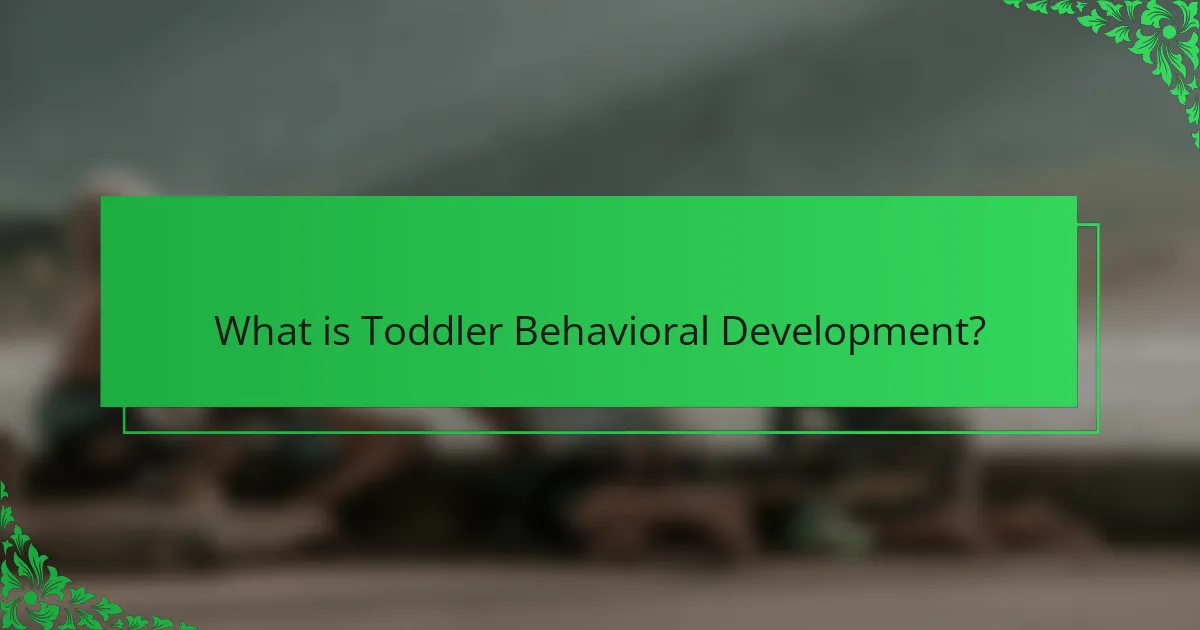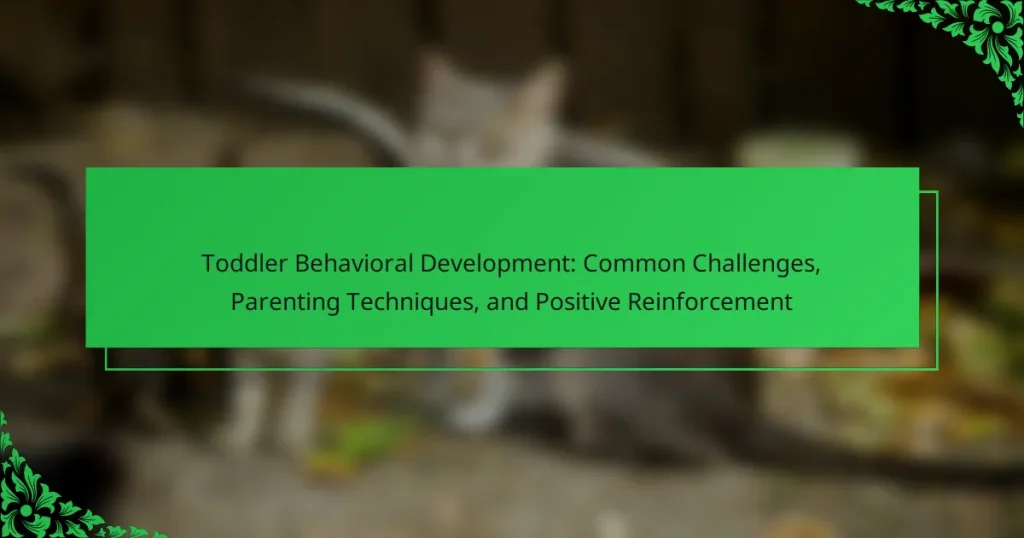
What is Toddler Behavioral Development?
Toddler behavioral development refers to the changes in behavior and social skills that occur in children aged one to three years. During this stage, toddlers begin to express emotions, develop independence, and learn to interact with others. They exhibit behaviors such as tantrums, mimicry, and exploration of their environment. Research indicates that around 75% of toddlers experience temper tantrums as they navigate their emotions. This developmental phase is crucial for establishing social norms and communication skills, laying the foundation for future interactions.
How does toddler behavioral development progress during early years?
Toddler behavioral development progresses through distinct stages characterized by increasing independence and social interaction. In the first year, toddlers develop attachment and basic social skills, primarily through interactions with caregivers. By age two, they exhibit more assertiveness, often expressing desires and frustrations verbally and non-verbally. This stage is marked by parallel play, where toddlers play alongside but not directly with peers. As they approach three years, toddlers begin to engage in cooperative play, sharing and taking turns. Emotional regulation also improves during this time, as they learn to express feelings more appropriately. Research shows that consistent routines and positive reinforcement from caregivers significantly enhance behavioral development in toddlers. Studies indicate that toddlers with supportive environments exhibit better social skills and emotional resilience.
What are the key stages of behavioral development in toddlers?
The key stages of behavioral development in toddlers include sensory-motor exploration, social interaction, language acquisition, and emotional regulation. During sensory-motor exploration, toddlers learn through their senses and movements. This stage typically occurs from birth to 2 years. Social interaction begins around 12 months, as toddlers start to engage with others. Language acquisition usually starts around 1 year, with toddlers beginning to say simple words. Emotional regulation develops gradually, often becoming noticeable between 2 and 3 years, as toddlers learn to manage their feelings. These stages are supported by developmental psychology research, which outlines typical growth patterns in early childhood.
How do environmental factors influence toddler behavior?
Environmental factors significantly influence toddler behavior. These factors include family dynamics, socioeconomic status, and physical surroundings. For instance, a nurturing home environment promotes secure attachment and positive behavior. In contrast, high-stress environments can lead to increased anxiety and behavioral issues in toddlers. Research shows that children exposed to consistent routines exhibit better emotional regulation. Additionally, access to safe play areas encourages physical activity, which is linked to improved mood and social skills. Overall, a supportive and stable environment fosters healthy development in toddlers.
What common challenges do parents face in toddler behavioral development?
Parents face several common challenges in toddler behavioral development. These challenges include tantrums, which often arise from frustration or inability to express emotions. Another challenge is defiance, where toddlers test boundaries and assert independence. Social skills development also poses difficulties, as toddlers learn to interact with peers. Additionally, parents may struggle with inconsistent behavior, as toddlers can switch from being cooperative to resistant quickly. Understanding these challenges is crucial for effective parenting strategies. Research indicates that 70% of parents report frequent tantrums as a significant concern during this developmental stage.
What are the most frequent behavioral issues encountered in toddlers?
The most frequent behavioral issues encountered in toddlers include tantrums, defiance, and aggression. Tantrums often occur when toddlers are frustrated or unable to express their emotions. Research indicates that approximately 75% of toddlers experience tantrums regularly. Defiance is common as toddlers assert their independence, leading to power struggles with parents. Aggression, such as hitting or biting, can arise from frustration or the desire for attention. Studies show that these behaviors are typical in early childhood development and usually decrease as communication skills improve.
How do tantrums and emotional outbursts manifest in toddlers?
Tantrums and emotional outbursts in toddlers typically manifest as intense crying, screaming, and physical aggression. These behaviors often occur in response to frustration, unmet needs, or overwhelming emotions. Toddlers may also display signs of defiance, such as refusing to comply with requests. During these episodes, they might hit, kick, or throw objects as a way to express their feelings. Research indicates that tantrums peak between ages 1 and 3, coinciding with a child’s developing sense of autonomy. Approximately 75% of children experience tantrums, making them a common aspect of toddler behavior. These outbursts can last from a few minutes to over 30 minutes, depending on the child and the situation.

What are effective parenting techniques for managing toddler behavior?
Effective parenting techniques for managing toddler behavior include setting clear boundaries and being consistent. Consistency helps toddlers understand expectations. Positive reinforcement encourages good behavior by rewarding desirable actions. Time-outs can be effective for teaching consequences. Redirection helps shift a toddler’s focus from negative behavior to positive activities. Modeling appropriate behavior provides a clear example for toddlers to follow. Active listening fosters communication and helps toddlers express their feelings. Research indicates that these techniques promote emotional regulation and social skills in young children.
How can parents establish routines to support behavioral development?
Parents can establish routines to support behavioral development by creating consistent daily schedules. Consistency helps children understand expectations. Regular meal times, play times, and bedtimes promote stability. This structure aids in developing self-discipline and time management skills. Research shows that predictable routines contribute to emotional security in children. According to a study published in the Journal of Child Psychology, children with established routines exhibit better behavior and coping skills. Parents should also involve children in routine planning. This inclusion fosters a sense of ownership and responsibility. Overall, structured routines are essential for healthy behavioral development in toddlers.
What role do consistent boundaries play in toddler behavior?
Consistent boundaries play a crucial role in toddler behavior. They provide a framework that helps toddlers understand expectations and limits. This structure fosters a sense of security and predictability. When boundaries are clear and consistently enforced, toddlers are less likely to test limits. Research shows that children with consistent boundaries exhibit better self-regulation and social skills. For instance, a study published in the Journal of Child Psychology found that predictable environments lead to more positive behavioral outcomes. Thus, consistent boundaries are essential for healthy toddler development and behavior management.
How can parents use modeling to influence positive behavior?
Parents can use modeling to influence positive behavior by demonstrating desired actions themselves. Children learn by observing their parents’ behaviors. When parents consistently exhibit kindness, respect, and honesty, children are likely to imitate those traits. Research shows that children are more likely to engage in prosocial behaviors when they see their parents acting in such ways. For example, if a parent shares toys with others, the child may learn to share as well. Effective modeling involves consistent actions that align with the values parents wish to instill. This approach reinforces the behavior through direct observation and imitation.
What strategies can parents employ to promote positive reinforcement?
Parents can employ several strategies to promote positive reinforcement. One effective method is to provide immediate praise when a child exhibits desired behavior. This reinforces the behavior and encourages repetition. Another strategy is to use specific feedback, such as saying, “Great job sharing your toys!” This helps children understand what behavior is being rewarded.
Additionally, parents can create a reward system, using stickers or tokens for good behavior. Research shows that tangible rewards can motivate children and reinforce positive actions. Consistency is crucial; parents should apply these strategies regularly to establish clear expectations.
Moreover, modeling positive behavior can also be effective. Children often imitate adults, so demonstrating kindness and cooperation can encourage similar actions. Lastly, maintaining a positive environment, where children feel safe to express themselves, supports overall behavioral development.
How does positive reinforcement differ from negative reinforcement?
Positive reinforcement involves adding a desirable stimulus to encourage a behavior. For example, giving a child praise or a treat for completing a task reinforces that behavior. Negative reinforcement, on the other hand, involves removing an aversive stimulus to increase a behavior. An example is allowing a child to leave the table after finishing their vegetables. Both methods aim to increase desired behaviors, but they operate through different mechanisms. Positive reinforcement adds a positive element, while negative reinforcement removes a negative one. Research indicates that positive reinforcement is often more effective in promoting long-term behavioral change in children.
What types of rewards are most effective for toddlers?
Effective rewards for toddlers include praise, stickers, and small toys. Praise reinforces positive behavior by providing immediate feedback. Stickers serve as tangible rewards that toddlers can collect. Small toys can motivate toddlers to complete tasks or exhibit desired behaviors. Research shows that positive reinforcement encourages learning and behavioral development in young children. According to a study by the American Academy of Pediatrics, immediate rewards help toddlers understand the connection between their actions and outcomes.

How can parents address specific behavioral challenges effectively?
Parents can address specific behavioral challenges effectively by implementing consistent strategies tailored to their child’s needs. Establishing clear expectations helps children understand acceptable behavior. Positive reinforcement encourages desired actions through praise or rewards. Setting appropriate consequences for negative behavior teaches accountability. Active listening fosters open communication, allowing children to express their feelings. Modeling appropriate behavior demonstrates how to handle situations. Seeking professional guidance can provide additional support and resources. Research indicates that consistent application of these techniques promotes better behavioral outcomes in children.
What techniques can be used to manage tantrums in toddlers?
Techniques to manage tantrums in toddlers include distraction, validation, and setting clear boundaries. Distraction involves redirecting the child’s attention to a different activity or toy. Validation means acknowledging the child’s feelings to help them feel understood. Setting clear boundaries helps children know what behavior is acceptable. Consistency in responses to tantrums is crucial for effective management. Time-outs can also be effective in helping toddlers calm down. Positive reinforcement encourages desired behaviors by rewarding them. Research indicates that these techniques can reduce the frequency and intensity of tantrums in toddlers.
How can parents stay calm during a toddler’s emotional outburst?
Parents can stay calm during a toddler’s emotional outburst by practicing deep breathing techniques. Taking slow, deep breaths helps regulate emotions. It allows parents to create a moment of pause before responding. Maintaining a neutral [censured] expression can also help in staying calm. This signals to the toddler that the situation is under control. Additionally, using positive self-talk can reinforce a calm mindset. Reminding themselves that this behavior is normal for toddlers can reduce stress. Staying consistent with routines provides a sense of security for both the parent and child. Finally, removing themselves from the immediate environment can offer a brief respite.
What are some best practices for implementing positive reinforcement?
Use specific, immediate rewards to reinforce desired behaviors. This helps toddlers associate their actions with positive outcomes. Consistency is key; apply reinforcement every time the desired behavior occurs. Tailor rewards to the child’s interests for greater impact. Use verbal praise alongside tangible rewards to enhance motivation. Gradually fade the use of tangible rewards to promote intrinsic motivation. Monitor progress and adjust strategies as needed to maintain effectiveness. Research shows that positive reinforcement can significantly improve behavior in children, as demonstrated in studies like “The Effects of Positive Reinforcement on Child Behavior” by Smith et al., published in the Journal of Child Psychology.
How can parents track and measure behavioral improvements?
Parents can track and measure behavioral improvements by using consistent observation and documentation methods. They should maintain a behavior journal to record incidents and progress over time. This journal can include specific behaviors, triggers, and outcomes. Parents can also use checklists to monitor targeted behaviors daily. Setting clear goals helps in measuring progress effectively. Regularly reviewing the collected data allows parents to identify patterns and improvements. Utilizing rating scales can provide a quantitative measure of behavior changes. Engaging with educators or therapists can offer additional insights into behavioral progress. Research shows that structured tracking enhances the ability to recognize improvements in child behavior (American Academy of Pediatrics).
What common mistakes should parents avoid when using positive reinforcement?
Parents should avoid being inconsistent with positive reinforcement. Inconsistency can confuse toddlers about expected behaviors. They should also avoid using rewards that are too extravagant. Overly lavish rewards can diminish the value of reinforcement. Additionally, parents should not wait too long to provide reinforcement. Timely reinforcement is crucial for effective learning. Another mistake is failing to reinforce small steps toward desired behavior. Recognizing incremental progress encourages continued effort. Lastly, parents should avoid using positive reinforcement as a bribe. This can lead to manipulation rather than genuine behavior change.
What practical tips can parents use to support toddler behavioral development?
Establishing a consistent routine helps toddlers understand expectations. Routines provide a sense of security and predictability. Parents can set specific times for meals, play, and bedtime. Engaging toddlers in play promotes social skills and emotional expression. Activities like role-playing and storytelling can enhance communication abilities. Positive reinforcement encourages desired behaviors. Praising toddlers for good behavior strengthens their self-esteem. Setting clear boundaries teaches toddlers about acceptable actions. Parents should remain calm and patient during challenging behaviors. Modeling appropriate behavior demonstrates expected actions. Consistent guidance fosters a supportive environment for behavioral development.
Toddler behavioral development encompasses the evolution of behavior and social skills in children aged one to three years, highlighting key aspects such as emotional expression, independence, and social interaction. This article explores the stages of behavioral development, common challenges faced by parents, and effective parenting techniques, including positive reinforcement strategies. It emphasizes the impact of environmental factors on behavior and provides practical tips for fostering healthy development in toddlers. Key issues like tantrums, defiance, and emotional regulation are addressed, along with methods for managing these behaviors effectively.




